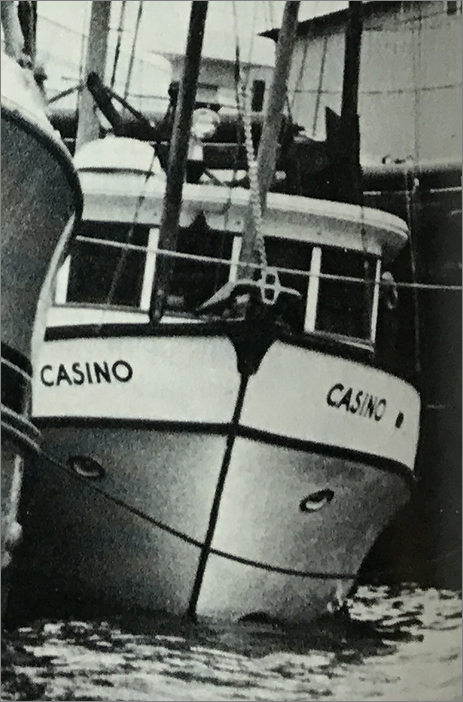With seven or eight people murdered onboard the Investor, the fear factor was immediate and overwhelming. It started in Craig, with some of the first witnesses. That fear was still palpable many years later. Indeed, that fear may well have influenced Dawn Holmstrom’s attempt to divorce herself from her own testimony to the Ketchikan grand jury, especially once the investigation focused on her friend John Peel. But Peel wasn’t the only suspect. Some suspected Dean Moon, another friend of the Bellingham witnesses.
That wasn’t the only problem. For the better part of two years, troopers failed to arrest anyone for perpetrating these murders. The fear lingered and twisted upon itself like a knot. Ultimately, that fear expressed itself in increasingly bizarre ways. Let’s take a look at some of the places it emerged, starting near the beginning.
Casino Crew: First Witnesses

(courtesy Doug McNair)
- When Bruce Anderson and Jan Kittleson learned of the murders, they took extreme precautions to protect themselves. They extinguished the diesel stove on the Casino to make sure they could hear people approaching. They closed the curtains to hide themselves from prying eyes. They locked the windows. They put chains across the galley door.
- When they went to the Hill Bar to identify a possible suspect — someone they’d seen on the Investor skiff, returning from the murder scene — they felt apprehensive, scared, even terrified. As a consequence, they barely set foot in the bar and failed to identify anyone.
Dawn Holmstrom

- In her grand jury testimony, Dawn Holmstrom continually referenced her fear. When asked if she was scared while chatting with John Peel at Ruth Ann’s, she answered, “Yes.”
- When asked what scared her, she answered, “His eyes. And I… I seen his eyes again when the newspaper carne out. His eyes were the same as when…” Dawn Holmstrom then broke down on the witness stand.
- ”Take your time,” the assistant D.A. told her, hoping to put her at ease on the witness stand. “Take your time.”
- “I know,” she said between sobs. And then she said, “Because he had a mask on and he looked — his eyes looked exactly the same as they did before. And it scared me,” Dawn sobbed. “And I didn’t know why I was so scared.”
Larry Demmert, Jr.

(courtesy A Current Affair)
- When troopers confronted John Peel in March, 1984, Larry Demmert was asked to bring some ammunition into the police station. When Demmert called Dave McNeill to make the hand-off, however, he wanted the cop to meet him at the Clark Market on James Street in Bellingham. He didn’t want him coming near his home, because he was scared and afraid someone might be watching his house.
- As grand jury proceedings started, Larry Demmert was “eating valium.” The next time the police saw Larry Demmert he was “acting strange.” Dawn Holmstrom told them, “he’s packing a gun around town.”
- Demmert told them the reason he had a gun was because he was scared. He told them he was afraid to walk down the street without carrying a gun. Somebody might recognize him, Demmert said, because he had a lot of relatives in Ketchikan and was known in the area. With a gun he felt safer. At least he could defend himself.
- On February 1st, 1985, when John Peel was negotiating bail terms, Demmert placed a personal call to Judge Schulz. “If he (Peel) is let out, I fear for my life and my family’s lives and several people that are involved in the case,” he told the judge’s clerk.
- “I’m scared and they are all scared. They know that they know and can’t talk about it, but the defense can talk about it. Public opinion seems to be swinging towards him and I don’t think that’s right. And to let him out when he has already murdered eight people, or is being brought to trial for eight murders, is just not right.”
The scientific literature has recently begun to come to grips with the complex feelings expressed above. “’Homicide survivors,’ also called ‘co-victims,’ are generally defined as the friends, family, and loved ones that survive murder victims… In contrast to other crime victims, homicide survivors often face greater intrusion of the media and criminal justice systems, as well as strained relationships with friends or family members that are suspected perpetrators.” [1]
The practical implications in the Craig murders were stark. Whoever killed the Investor crew was free. Free to kill again. Witnesses had to think twice about coming forward.
“Surrounding this normal pattern of grieving, homicide survivors are also confronted with intense and often paralyzing feelings of fear, as well as near-consuming thoughts of revenge… This fear is virtually impossible to comprehend, contain, or explain with words. Survivors are apt to vacillate between a state of psychic-separation (characterized by numbness, denial, and disbelief) and over-connectedness (during which they are painfully aware of the presence of the event in every thought, image, and emotion).” [2]
[1] Journal of Traumatic Stress, “Losing a Loved One to Homicide: Prevalence and Mental Health Correlates in a National Sample of Young Adults,” Heidi Zinzow et al, 2009 Feb; 22(1): 20–27
[2] Annals of the American Psychotherapy Association (Vol. 10, Issue 3.), “Life sentence: co-victims of homicide,” Bruce Gross, Sept. 22, 2007
Excerpts from the unpublished original manuscript, “Sailor Take Warning,” by Leland E. Hale. That manuscript, started in 1992 and based on court records from the Alaska State Archive, served as the basis for “What Happened in Craig.”
Copyright Leland E. Hale (2019). All rights reserved.

Order “What Happened In Craig,” HERE and HERE. True crime from Epicenter Press about Alaska’s Worst Unsolved Mass Murder.